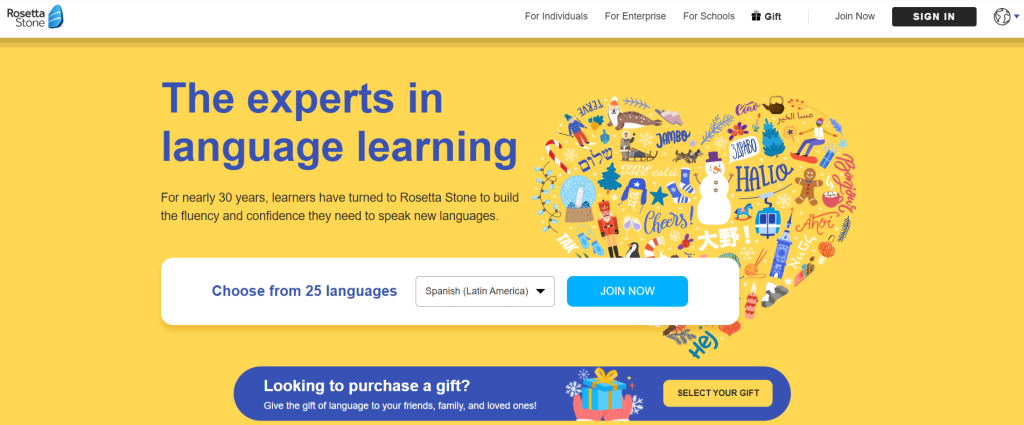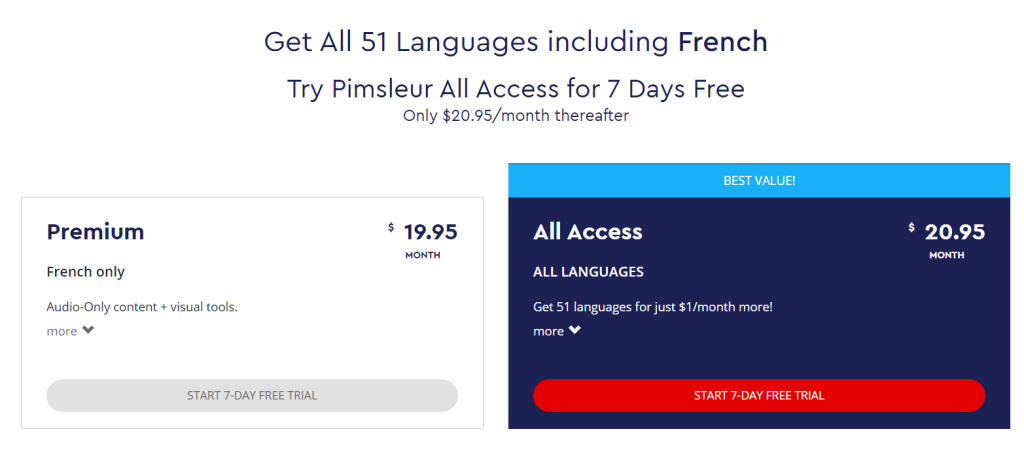As someone who has used both Pimsleur and Rosetta Stone extensively to learn Spanish, I’ve gotten to experience the pros and cons of these popular language learning programs firsthand.
If you’re trying to determine which platform would be better suited to help you gain fluency in a new language, you’re probably wondering – which one is the more effective option? Should you learn through quick audio lessons or visual software sessions?
My goal is to equip you with an unbiased assessment of the key strengths and weaknesses of Pimsleur and Rosetta Stone, so you can determine which solution aligns better with your learning goals and style.
Pimsleur Vs. Rosetta Stone: A Quick Overview
| Feature | Pimsleur | Rosetta Stone |
| Teaching Method | Auditory-based learning with speech recognition | Visual-based learning with images/diagrams |
| Course Structure | 30-minute audio lessons focused on conversation | Interactive software lessons in units |
| Languages Available | Over 50 languages available | 28 languages available |
| Continual Practice | Gradually reinforces and repeats concepts | Moves through concepts more quickly |
| Feedback Provided | Detects pronunciation; limited grammar feedback | Detailed grammar and word choice feedback |
| Compatibility | Audio courses compatible with any device | Requires software/app access on the device |
| Pricing | $20.95/month for all languages | $12/month for all languages |
| Ideal For | Beginners learning conversational skills | Developing well-rounded reading/writing skills |
How Do Pimsleur Courses Work?
Pimsleur courses are generally audio-based language programs. The main idea behind Pimsleur is to learn by hearing and speaking aloud. But in addition to the audio clips, you’ll get tons of PDFs, games, and other exercises that help you evaluate your learning progress. Get to know more about Pimsleur through our detailed review here.
The audio lessons are usually not more than 30 minutes long. These audio clips cover real-life conversations to help you speak as fluently as a native speaker.
Furthermore, the conversations are broken into manageable chunks so that every learner can grasp the idea easily. The audio lessons have words and phrases with translations. These words or phrases are said in a particular context to give you a clear idea of the right way of using these words.

The pace of the lessons is really good. The audio pauses after every sentence and asks you to repeat them. It helps in memorizing the words and phrases better.
Furthermore, each language has five levels. Based on your learning requirements, you can pick any. There are 15 to 30 lessons at each level that cover all basic things to make you an expert learner.
The levels are organized based on complexity and difficulty. In level one, you’ll be introduced to basic words and phrases. By level five, the audio clips get a bit fast. And the conversations move faster to help you learn how the natives speak. You’ll also be introduced to new complex vocabulary so that you can speak confidently in any situation.
For example, there are thirty audio lessons at all levels of the French program. The audio clips are usually not longer than thirty minutes. There is a moderator who introduces you to the lessons.
You’ll listen to short exchanges of words between two native French speakers. Then the moderator will explain the gist of the conversation in English.
After explaining, it’ll ask you questions to evaluate your understanding. The moderator also gives some pro tips and advice to memorize and learn better.
After each lesson, there are lots of exercises & drills such as reading short passages, flashcards, pronunciation training, speed learning tests, quizzes, and more.

Solving these drills may take you around thirty minutes more. So one Pimsleur lesson usually takes one hour to complete. The moderator starts speaking less English and more French when you progress through the course. This technique is enforced to help you remember what you’ve learned.
Also, the best thing about Pimsleur lessons is that you’re not forced to follow a rigid structure. You can jump from lesson to lesson or from level to level. So, if you feel some lessons are repetitive or boring, you can skip them.
Overall, Pimsleur has something for every learner, whether you’re a complete beginner or want to brush up your foreign language speaking skills.
But please note that the lessons are not as in-depth for less popular languages, Arabic, Thai, etc. Exercises, drills, and quizzes for these language courses are limited compared to French, Spanish, etc.
How Do Rosetta Stone Courses Work?
Now let’s talk about the course structure of Rosetta Stone. Rosetta Stone is equally good as Pimsleur and has its course structured for both beginners and advanced learners.
But what sets Rosetta Stone apart from most language learning platforms is its TruAccent Speed Recognition Technology.

The technique is basically all about repeating words and phrases, explaining what you see in the pictures, and filling in the blanks while the lessons go on. So the core idea is to listen when you speak the language.
And if you mispronounce the words or sentences, you’ll have to say them again until you pronounce them correctly.
Talking about the individual courses, each course is divided into different units, and there are multiple lessons inside each unit. For example, the French program has 20 units, each with lessons catering to different categories.
The lessons are usually thirty minutes long. They are followed by some exercises and drills like- grammar, pronunciation, listening, and writing, which will take another 10 to 15 minutes. So you’ll spend around an hour in each lesson.
As I mentioned, Rosetta Stone’s lessons mostly revolve around hearing the sounds and phrases and repeating them. You’ll listen to a word or phrase, repeat it, and then match the word with a corresponding image.
Basically, Rosetta Stone lessons target both your auditory and visual sensors to help you memorize everything better. The lessons start with very easy and basic words.
As you progress, you’ll learn more complex words and sentences. But to progress through the lessons, Rosetta Stone recommends that you should score at least 85% in each lesson.
The best part about Rosetta Stone is that it puts heavy emphasis on speaking. The verbal approach is the best way to learn a new language, and Rosetta Stone does it the best.
However, there is no level of segregation in Rosetta Stone like in Pimsleur. But that does not make any significant difference because the lessons are planned stage-wise- from beginner to advanced learners.
Pimsleur vs Rosetta Stone: Pros & Cons
Here are the pros & cons of Pimsleur and Rosetta Stone.
Pimsleur Pros
- Pimsleur uses a highly effective teaching method to teach any language, and it is called the Pimsleur Method.
- It also offers audio lessons with English translations, making it easier for you to learn the vocabulary of any language.
- Pimsleur has the most flexible programs that allow you to learn on the go.
- You can learn the pronunciation of any language perfectly with its audio lessons.
- The user interface of Pimsleur is smooth and user-friendly.
Pimsleur Cons
- The learning process of Pimsleur courses is slow, and you will need to give a lot of your time to be good at any language.
- If you are a visual learner, then you will be disappointed with Pimsleur courses.
Rosetta Stone Pros
- Lessons from Rosetta Stone are a bit shorter and focus more on visual learning.
- Voice recognition technology helps you improve your pronunciation.
- Rosetta Stone’s learning methods focus on teaching you a new language in a fun and gamified way.
- You will also learn the proper grammar of the language you want to learn so you can also read and write.
- Rosetta Stone also offers extra learning resources such as stories, on-demand videos, and phrasebooks.
Rosetta Stone Cons
- The English explanations are very less than Pimsleur, which makes it difficult for you to understand.
- The learning process may feel repetitive and can get boring after a time.
Price Difference Between Pimsleur And Rosetta Stone
Price is also another determining factor when it comes to choosing a language learning platform.
Pimsleur offers two subscription plans- the premium and the all-access plan. The premium plan is available for $20 per month, and the all-access plan is for $21 per month. We also have an exclusive Pimsleur coupon code to help you save a few bucks.

On the other hand, Rosetta Stone offers three plans- 3 months, 12 months, and the lifetime access plan. The prices of each plan go as follows-

| 3 Months | 12 Months | Lifetime |
| $11.99 per month (35.97 billed one time) | $7.99 per month ($95.88 billed annually) | $179 one-time payment |
Based on the price plans, Rosetta Stone is a clear winner. The prices are quite reasonable and flexible too. If you’re a linguist or have an interest in speaking different languages in general, you may opt for the yearly or lifetime plan. Otherwise, the three-month plan is best for learning a single language. You can also check our Rosetta Stone discount code here to save a few bucks on it.
Pimsleur Vs. Rosetta: Which One Is The Best?
Now let’s address the elephant in the room. Pimsleur vs. Rosetta Stone: Which one is better? While both platforms provide enough resources to make you a fluent speaker, I would say Pimsleur is slightly better than Rosetta Stone.
I like the course structure of Pimsleur better. It nicely segregated the course structure from beginner level to advanced learners. Also, the lessons are more detailed, and Pimsleur places emphasis on in-person conversations, while Rosetta Stone is more about simply hearing them.
Even though Pimsleur is slightly more expensive than Rosetta Stone, it’s completely worth the price, considering the resources and emphasis it puts into making you a fluent speaker.
Pimsleur follows the listen-repeat-call-response pattern, which is really effective for memorizing whatever you’ve learned. Overall, Pimsleur’s learning is in many ways better than Rosetta Stone.
Related Read:
Conclusion: Pimsleur vs Rosetta Stone
Learning a foreign language isn’t that tough when you have the right guidance. While there are many language learning platforms, most of them don’t provide what they promise. Rosetta Stone and Pimsleur are two top platforms that help you become an expert learner.
But after comparing the course materials, considering reviews of different users, and based on my own learning experience, it’s pretty clear that Pimsleur is a better online learning platform compared to Rosetta Stone.
